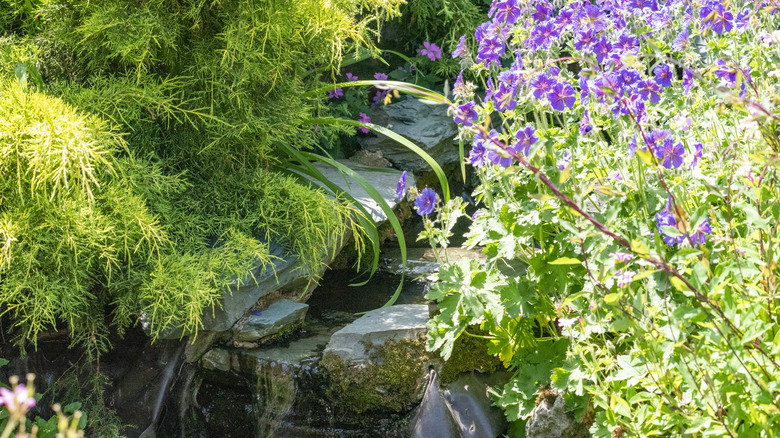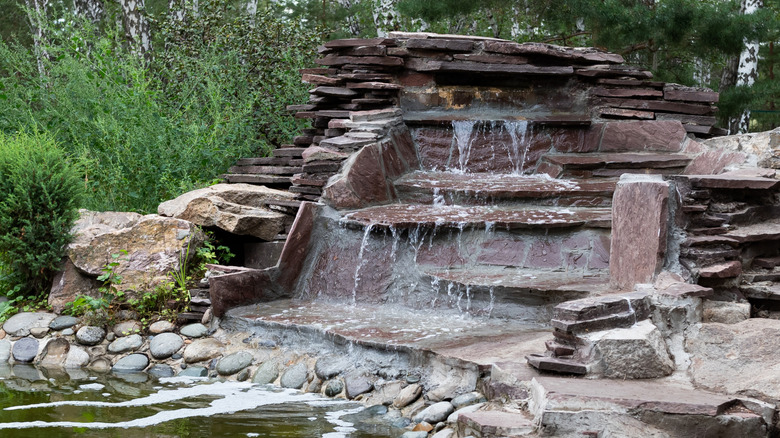The Stunning Natural-Looking Waterfall You Can DIY In A Single Day
We may receive a commission on purchases made from links.
Spending time in your backyard is one of life's simple pleasures, whether it's entertaining friends and family or simply soaking up the sun on a Saturday afternoon. As we all know, implementing gorgeous backyard design ideas and keeping up with general maintenance is no easy feat, but if you're looking for ways to turn your backyard into a secret garden oasis, you may want to try out an easy waterfall DIY project. The main components you'll need for this project are a preformed pond basin in a size that fits in your garden, like this Algreen Products Avonlea Rigid Preformed Pond Liner. You'll also require a rubber lining material to line the shape of the waterfall, a bag of sand, a water pump, a pond hose, and flagstones to construct the waterfall.
Before you start, choosing the right location for your waterfall is key. Try to pick somewhere that's on a natural slope and that has enough surrounding space. You also want to make sure that the area doesn't get too much sunlight and is ideally shaded by a tree. Too much sun exposure will encourage algae growth, turning your waterfall green and reducing the clarity of the water. The fountain will also need full sun if it's solar powered or proximity to a power source to plug in your pump.
DIY a simple backyard waterfall with flagstone
The right water pump matters for this DIY, so there are a few things to consider: the width of the water channel, how high the pump will need to lift the water, how long the pond hose is from the pump to the top, and what kind of speed you want your flow to be. As a general guide, for about every 1 inch of waterfall width, you are likely to need a flow of 100 gallons per hour. A weaker pump will produce a more spring-like trickle.
Begin by digging a hole that fits your preformed pond basin. You can use sand to balance out the surface underneath and to make sure that it is held securely. Use a rubber lining to outline the shape of your waterfall and hold it in place with some rocks. Next, stack your flagstones starting with larger rocks on the bottom, then work your way up to the top. Aim for a cascading formation that creates some caverns and ledges where water can spill over the edges. Pop your pump into your waterfall reservoir and run the pond hose up the waterfall, trying your best to wedge it and hide it behind the rocks. Fill the reservoir with water and turn on the pump to test the flow and move rocks as needed.
Ways to personalize your waterfall
There are lots of fun ways to make your garden waterfall feel unique to you and your outdoor space. Choosing unique materials to build your garden waterfall will showcases some of your favorite gardening elements, and ensure that you'll love the feature in years to come. Flagstones are a popular and practical choice and they provide a rustic feel. However, you can choose nearly any kind of material that is suitable for outdoor use. For example, you can use concrete blocks, bricks, or even acrylic panels if you're wanting to create a contemporary looking garden.Another useful tip to cover up any pond liner that may be exposed is to use small decorative stones around the edge of your waterfall to fill any obvious gaps.
If attracting birds to your garden is a priority, then there are a few tips to follow. Create a safe drinking spot in your waterfall by making sure there's at least one sizeable flat platform for birds to stand on. Decorating the outline of your waterfall with native plants will also create an extra habitat and hiding place for birds and insects. Consider planting floating plants to act as a resting place for insects and other wildlife; waterlilies and water hawthorn are great options.

